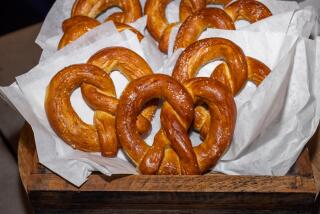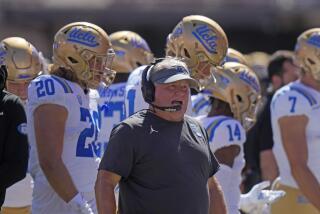Tackle that cheese
The snacking habits of Washington State University football fans could have been politely ignored had their team, the Cougars, not shut UCLA and USC out of the Rose Bowl. Now the only salve for our bruised egos is gustatory. We must sneer at their cheese.
Angelenos, wrinkle your noses: At home games, Cougar fans snack on 8-ounce bags of something called “green cheese.” Alarming name aside, it’s not really green. The term refers to its youth. It’s a bright white, squeaky new cheese, and consuming it is the lactic equivalent of eating cookie dough.
But even when these young curds are treated properly -- that is to say pressed, aged and turned into real cheese -- those indefatigably original artisans of Cougar country cannot resist dealing their cheese another novel touch. They can it. WSU produces what is, to my knowledge, the only canned cheese in America outside, of course, of Cheez Whiz.
This sort of WSU-bashing is always good for a guffaw from Bruin-supporting Brie eaters. Alas, all this highly therapeutic bad sportsmanship must end here. For on inspection, WSU’s canned cheese, called Cougar Gold, is less ridiculous than remarkable. It is not only perfectly edible, it’s distinctive, quirkily American, even historic and, as a final insult, the product of a program that this far more cheese-proud state would do well to emulate.
California may be the No. 1 milk state and No. 2 cheese state (after Wisconsin) in the land, but we have nothing to match the Cougars’ cheese plant, the WSU Creamery. Meanwhile, the Pullman campus of the state university of Washington (the No. 9 milk state) has had a creamery for most of the last century, and a commercial cheese plant since the 1940s.
The idea to teach dairy science in a region better known for wheat and lentils was nothing exceptional. Land grant universities have dairy departments in most places where people drink milk. However, WSU’s dairy department has a history of oddball gumption. Vintage photographs show pig-drawn carts transporting milk from the university teaching farm to a campus creamery open to the public in the 1920s. In the run-up to World War II, the WSU Creamery turned to cheese-making and in the 1940s, it won a contract to develop a cheese that could withstand the hardships of battlefields and bomb shelters. This meant canning it.
The American Canning Co. provided the cans. The university technologists isolated a bacterial cheese culture, which they named Cougar 19, and is now an official trade secret. The campus became the proud owner of a sealer called a “Pacific Semi-Automatic Vacuum Closing Machine.” Cougar Gold was born.
The result is like no other cheese. Canned in newly pressed wheels and then aged for a year, the finished cheese has a certain tang that we associate with aged Cheddar.
WSU press releases liken it to a Gouda, which would be right if it weren’t 100% wrong. A year-old Gouda is like a fine Parmesan: nutty, crumbly and salty from the slow evaporation of the water from the cheese. By contrast, at 12 months, Cougar remains ever-wet and soft. The cans mean that moisture does not evaporate the same way it leaves traditional farmhouse cheeses.
The moisture seems to be behind the need to refrigerate the cans. “Once it gets warm, the texture breaks down,” says dairy manager Russ Salvadalena. “It can withstand shipping over a, say, 10-day period, then re-refrigeration,” he adds, “but you don’t want to leave it in the back window of your car and drive from here to Seattle. You’d get a kind of mush in there.”
The need for refrigeration seems to be what disqualified Cougar Gold from a career in the military. But its resilience in the hands of the U.S. Postal Service did allow what was originally conceived as a milk equivalent of Spam to evolve into a Christmas food instead, with the 30-ounce cans moving briskly at $14 per pound plus shipping and handling. (They can be ordered from the WSU Creamery at [800] 457-5442, or through its Web site, at www.wsu.edu/creamery.)
At the height of the recent Christmas rush, only days after the Cougars’ win over UCLA shut USC out of the Rose Bowl, Salvadalena opened the dairy to this visiting Trojan fan. It was salt in the wound, readers. This creamery not only is a teaching facility, it creates dozens of student jobs, pays for a number of faculty positions and provides a catering outlet serving cheese, ice cream and coffee on campus.
An observation window allows customers a view of the cheese-making process, though few get up early enough to see students drive a tanker away at 4 a.m. to collect milk from the farm housing the university’s herd of 175 Holsteins. They return by dawn with anywhere from 9,000 to 11,000 pounds of milk, which is tested for fat and protein content, and antibiotic residues, before being pasteurized, cultured, cut up into curds, drained and salted.
This salting stage is where green cheese was born.
After the cheese is thoroughly mixed, says Salvadalena, “we grab 10 to 20 pounds of fresh curd and bag it up.” This is sold as a snack to football fans. “They eat it like popcorn,” says Salvadalena.
It is as bland as milk and bouncy as new rubber: perfect for throwing at USC fans.
Most of the curd, however, is decanted into hoops, where it is pressed and drained, then sliced into wheels, canned and aged for a year.
Last year, the Cougar creamery made 350,000 pounds of cheese from 3.5 million pounds of milk. They make some other cheeses, a low-fat one, another with jalapenos and so on, but far and away the bulk of it is canned Cougar Gold.
The Christmas rush creates a seasonal glut of cans. To help use these up, the university Web site has posted suggestions for what to do with them after eating the cheese.
This year’s ideas included poinsettia perch, trivet, bird feeder, candy dish and drum kit. WSU fans, evidently, also wear them on their heads during football games.
Perhaps we Californians can start with wooden Camembert boxes and see how our guys do next year?


